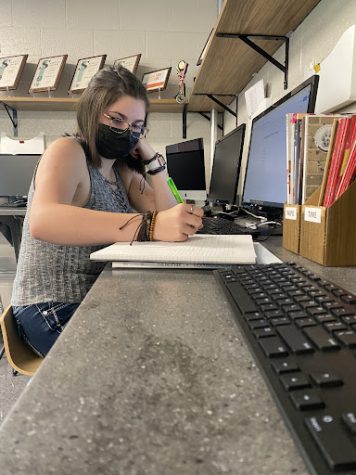Floating away with the clouds
The effects of seasonal affective disorder will lower as the sun comes out more

Practicing discus, Sophomore Carissa Heinzman tries to perfect her double spin, after over coming the obstacles after extensive foot surgery. She excels and has broken personal records thus far this season.
Sophomore Ben Young plays sports year round. From the fall to spring, he is either playing soccer on the field or in an indoor stadium he also runs on a track. “It’s nice to be outside instead of inside all the time,” Young said. “Being in the sun and running really boosts my mood, unless it is too hot.”
While the temperatures rise and the sun comes out in mid-April, Michigan is still the seventh cloudiest state in the nation with only about 65-75 clear days, according to Farmers’ Almanac. This means that the average resident of Michigan is limited to sunlight, which can improve or escalate moods and mental health.
Sunlight can be a key factor in signaling certain chemicals in the brain to be released.
A common health issue referred to as Seasonal Affective Disorder, otherwise known as SAD, subsequently “affects at least 20% of ten million Americans, but is most commonly found in women,” according to Psychology Today.
Many factors can contribute to this condition. “Individuals at highest risk for SAD are people who work night shifts and sleep during the day,” Lydia Zuker, a psychometrician and a clinical social worker at PAR Rehab in East Lansing, said. “People who are naturally susceptible towards being Vitamin D deficient are also at risk for SAD.”
There are a few ways to help prevent SAD. “Taking Vitamin D supplements, spending time outdoors in the sun, and lying under tanning beds and sun lamps,” Zuker said; although she does not recommend tanning bed use.
A happy chemical known as serotonin releases in your brain to boost your mood, by being outside or going to light therapy can help. That same chemical can be released when you see or interact with a dog.
Seasonal Effective Disorder can affect anyone, even people who move states or even continents like seventh grade science teacher Hannah Reyes, who acquired it after moving back to the the states from Africa.
“I have a sun lamp that wakes me up at 5:30 a.m. every day in the morning in the winter. It is like a big cup of coffee,” Reyes said.
Melatoin, also known as the chemical that helps you sleep, is even affected by the sun. It can turn on or turn off by using a sunlamp. This allows people who suffer from SAD to have a more relaxed and easy slumber at night and helps wake them up in the morning by triggering their nocturnal melatonin.
When melatoin gets turned off, energy levels are turned on. One of the major side effects of depression and SAD in general is tiredness.
So, by staying in the sun and making sure you are taking care of yourself mentally, SAD symptoms can be reduced.








